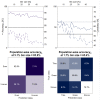Uneven Terrain Recognition Using Neuromorphic Haptic Feedback
- PMID: 37177725
- PMCID: PMC10181691
- DOI: 10.3390/s23094521
Uneven Terrain Recognition Using Neuromorphic Haptic Feedback
Abstract
Recent years have witnessed relevant advancements in the quality of life of persons with lower limb amputations thanks to the technological developments in prosthetics. However, prostheses that provide information about the foot-ground interaction, and in particular about terrain irregularities, are still missing on the market. The lack of tactile feedback from the foot sole might lead subjects to step on uneven terrains, causing an increase in the risk of falling. To address this issue, a biomimetic vibrotactile feedback system that conveys information about gait and terrain features sensed by a dedicated insole has been assessed with intact subjects. After having shortly experienced both even and uneven terrains, the recruited subjects discriminated them with an accuracy of 87.5%, solely relying on the replay of the vibrotactile feedback. With the objective of exploring the human decoding mechanism of the feedback startegy, a KNN classifier was trained to recognize the uneven terrains. The outcome suggested that the subjects achieved such performance with a temporal dynamics of 45 ms. This work is a leap forward to assist lower-limb amputees to appreciate the floor conditions while walking, adapt their gait and promote a more confident use of their artificial limb.
Keywords: FPGA neuron model; Izhikevich; PSTH-based classification; lower-limb impairments; neuromorphic haptic feedback; tactile augmentation; terrain recognition; wearable assistive robotics.
Conflict of interest statement
N.V. and S.C. have commercial interest in the spin-off company IUVO Srl, which is the exclusive licensee of the foot pressure sensors technology.
Figures







References
-
- Alfuth M., Rosenbaum D. Effects of changes in plantar sensory feedback on human gait characteristics: A systematic review. Footwear Sci. 2012;4:1–22. doi: 10.1080/19424280.2011.653990. - DOI
-
- Petrini F.M., Valle G., Bumbasirevic M., Barberi F., Bortolotti D., Cvancara P., Hiairrassary A., Mijovic P., Sverrisson A., Pedrocchi A., et al. Enhancing functional abilities and cognitive integration of the lower limb prosthesis. Sci. Transl. Med. 2019;11:512. doi: 10.1126/scitranslmed.aav8939. - DOI - PubMed
-
- Diaz J.P., da Silva R.L., Zhong B., Huang H.H., Lobaton E. Visual Terrain Identification and Surface Inclination Estimation for Improving Human Locomotion with a Lower-Limb Prosthetic; Proceedings of the 2018 40th Annual International Conference of the IEEE Engineering in Medicine and Biology Society (EMBC); Honolulu, HI, USA. 18–21 July 2018; pp. 1817–1820. - DOI - PubMed
MeSH terms
Grants and funding
LinkOut - more resources
Full Text Sources
Medical

